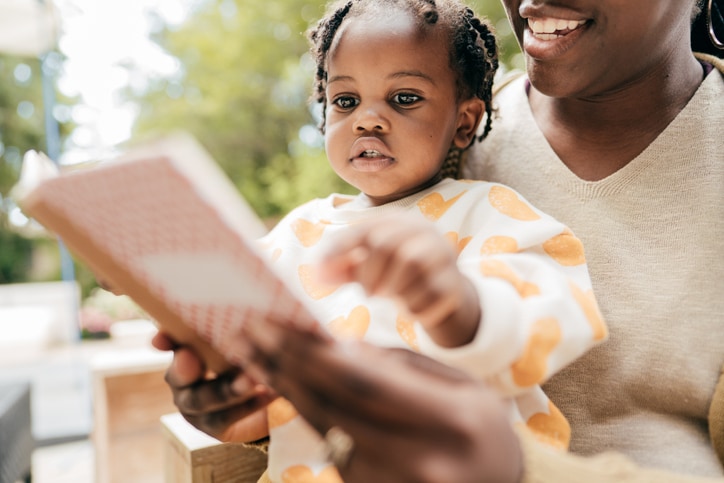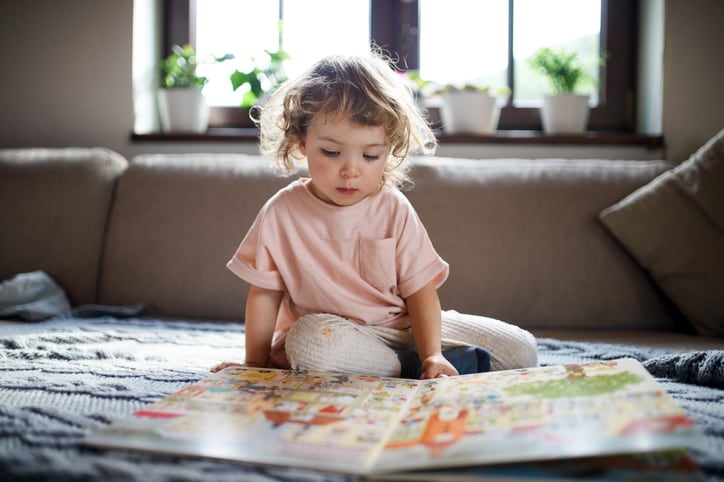Anyone who spends time with toddlers knows how challenging it can be to help a child work through a tantrum. You start to see the signs and dread the oncoming hurricane of raw emotion. You might remind yourself that tantrums are a totally normal part of development, that the child is just beginning to learn how to handle all of the complicated feelings that come along with being a person in the world. While this is true, it doesn’t make it any less frustrating in the moment.
Tantrums will happen, but there are ways to help a child work through their feelings in a healthy way — both for the child and you. Dr. Whitney Casares, board-certified pediatrician and CEO and founder of Modern Mommy Doc, says the best way to prevent tantrums is to set expectations for kids. “Letting kids know ahead of time what’s going to be happening or what kids can expect can help to decrease that expectation-reality gap that often happens for us as humans, but especially for little ones,” says Casares.
Preventing tantrums is ideal, but when they do happen, it’s good to have a few calming activities in your back pocket to help the child relax. Different calming techniques will work better for different children, so here are 50 different calm-down strategies for kids gathered from experts, science-backed studies and my own experience babysitting, nannying and working in the preschool classroom.
1. Smell the flower
I’ve seen this one work wonders for preschoolers overwhelmed with emotion. Bring the tips of all five fingers together facing up to make what sort of looks like a flower. Then, together with the child, lean in and “smell the flower.” This will help them take a big, deep breath in while also allowing for some imagination. In fact, a study from the Stanford Graduate School of Education found that introducing children to deep breathing techniques can help children calm down in stressful situations.
2. Blow out a birthday candle
You can use this in conjunction with smelling the flower. After breathing in, hold up one finger and tell the child to blow out the birthday candle. Most kids love birthday candles, so this is a fun way to encourage a child to take a long exhale. Repeat as many times as you need to. (Pro tip: the number of fingers they hold up can match their age, so three candles if they are 3, etc.)
3. Roar like a dragon
Another way to encourage deep breathing in a creative way is to roar like a dragon. This might be especially useful if the child is feeling angry or frustrated about something, as it will give them a chance to express those feelings in a healthy way. Breathe in to prepare for a big, loud ROAR!
4. Catch a bubble in your mouth

I’ve seen this used in many preschool classrooms as a way of getting a group of children to quiet down and listen to instructions. If you’re in a space where you just need a child to be quiet for a minute, try telling them to “catch a bubble” in their mouth by closing their mouth and holding air in their cheeks while breathing through their nose.
5. Stomp it out
When calming techniques like breathing deeply aren’t working, show the child how to “stomp it out.” This is perfect for a child who is feeling really angry and needs something physical to do. You can set up two footprints with construction paper to use whenever needed, so the child can place their feet on the footprints and just stomp out all of their anger. Cheryl Kagawa-Constantini, a preschool teacher in UC Berkeley’s Early Childhood Education Program, describes this strategy as “something tactile to use to focus body sensations on” and says it helps with self regulation. Kagawa-Constantini, who has decades of experience teaching preschoolers, refers to it “like a reset button.”
6. Push it out
Similar to stomping it out, Kagawa-Constantini also encourages her students to try pushing out their anger by placing both hands on a wall and pushing as hard as they can. For both pushing and stomping, a paper cutout isn’t necessary, but it can be helpful to have something tangible prepared already if you find yourself coming back to these calming strategies over and over.
7. Take a walk

Getting some exercise might help alleviate emotional difficulties, according to this study published in School Mental Health, a multidisciplinary research journal. Going on a walk will not only give you both some fresh air, but there are so many things to see and think about on a walk, especially for a young child. If you’re lucky enough to see a garbage truck in action, it might completely turn your day around!
8. Run around the block
If you think getting outside will help, but the child has a lot of frustrated energy, see if they want to run around the block with you. You can make it a race or just do it side-by-side. If the child wants to do something independently, have them run to the end of the block and back while you’re watching, if it’s safe to do so where you are.
9. Take a rest
Sometimes you can tell that a child’s tantrum is coming from tiredness. If this is happening at a time that isn’t a typical sleeping time, or if the child is completely resistant to the idea of going to sleep, ask them to try just taking a rest. This could mean laying on the couch and listening to a story or sitting and watching their favorite show. A naptime trick I’ve picked up in the classroom is telling the child they don’t have to go to sleep, they just have to close their eyes and rest for a bit. Even if they don’t fall asleep, they’ll likely calm down.
10. Stretch it out
Stretching is a great way to reconnect with your body and ground yourself. Teach the child a few simple stretches that they can use when they’re feeling stressed out.
Check out these ideas for stretching activities from the Children’s Healthcare of Atlanta:
11. Shake it out
Shaking your feelings out is a great alternative to stretching for a kid with a little more energy to release. Kagawa-Constantini uses this in her classroom to redirect restless energy before a focused activity. She also sometimes uses “dancing it out” in a similar way.
12. Wiggle your fingers and toes
My mom taught me this trick for helping wake up in the morning, and I still use it all the time. If you suspect the child’s frustrations are coming from sleepiness, tell them to wiggle their fingers and toes. When I’ve suggested this to sleepy preschoolers in my classroom, they usually think it’s fun and silly, and it helps them wake up a little.
13. Scream as loud as you can!
This only works if the environment allows, so if you’re in the middle of the grocery store … try something else. But if you’re at home and you can be as loud as you want, try just counting to three and screaming really loud together to get out all those hard feelings. I used to nanny a kindergartner who got very angry when he had to do homework, and it was a constant struggle to get him to sit down and start working on it. After trying to reframe homework time in a positive light, I realized the best thing for this child was to validate his feelings and let him scream his frustrations out before starting. If you make it clear that we can’t just go around screaming whenever we want, it could help the child learn when it is and is not appropriate to scream and prevent them from screaming in inappropriate situations in the future.
14. Throw a ball really hard
Similar to screaming, throwing a ball really hard can help with getting some anger out of your system. Go outside if you can, or use a soft-type ball and clear a zone inside the house where nothing will break. I used this strategy with the same kindergartner sometimes as well, using his backyard trampoline as a safe place to throw a ball really hard.
15. Eat a popsicle in the shower
This might sound weird, but parents and experts say that the combination of cold and hot can help reset your mood. Plus, who doesn’t love popsicles?
16. Blow some bubbles
One of the most powerful babysitting tools is a bottle of bubbles. Bubbles are magical and endlessly interesting to most young kids, meaning they work well as a distraction. I used to do this all the time with my younger cousin when she would wake up grumpy from naps. Try sitting on the front porch for extra stimulation.
17. Squish a stress ball
Stress balls can be very effective for kids and adults. Keep one handy to offer to a child who is feeling stressed out or overwhelmed. When I was a camp counselor, we kept a few stress balls around and kids would often go and grab them when they were needed to cool down.
18. Squish a stuffed animal
If a stress ball isn’t interesting enough to the child, bring them their favorite stuffed animal and tell them to hug it or squish it as hard as they can. It could have the same effects as a stress ball, and the child will be able to see something familiar and warm.
19. Hug a pet
Kids with pets (ones that are OK with physical contact) can try cuddling with or petting a furry friend as a way of calming down. In fact, a study of schoolchildren and pets, published in the Journal of the International Society for Anthrozoology, found that children with positive pet relationships have greater social-emotional skills. You may even prompt an impassioned child to tell the pet how they’re feeling if they don’t want to share with you in the moment.
20. Use the “hand method”
TikTok creator and mom Steffie Laa shows a calm-down trick that works well for her toddler. Hold up your hand so the child can trace your handprint with their fingers. Teach the child to breathe in when their finger is going up and out when their finger is going down.
21. Use a fidget toy
Fidget toys can be great for satisfying sensory needs in a calm way for some children. Offer the child a fidget toy to give them something to focus on and something to do with their hands. These might be especially useful in public spaces when trying to prevent a potential meltdown from escalating. At least one recent study has shown that fidget spinners can be effective at increasing on-task behavior for students with ADHD, but evidence of their benefits beyond that is still purely anecdotal.
22. Put on some noise-canceling headphones
Sometimes the world can be really overwhelming and kids just need a break. When you can’t physically give the child space, a pair of noise-canceling headphones can help them feel a little less overwhelmed by their surroundings. In the classroom where I work, we keep a couple pairs of headphones around and offer them to children when they start to become overwhelmed by the environment.
23. Make a glitter calm-down bottle
A glitter calm-down bottle can be used to help soothe a child’s anxiety by giving them something fun and interesting to focus on. This strategy might be better for younger children who haven’t learned how to talk about their feelings yet.
24. Try “calmhousing”
Calmhousing is like the opposite of roughhousing; the playing is done extra calmly and gently. When the child is frustrated because of pent-up energy, suggest “calmhousing” as a way of getting their body moving without risking anyone getting hurt. You may want to practice “calmhousing” regularly, when the child is not experiencing a meltdown, so they already know what it is and what the rules are.
25. Slow-mo fighting
Similar to “calmhousing,” if you’re caring for two children who always want to fight when they’re upset with each other, try slow-mo fighting. I used to nanny two brothers who tended to get physical when they disagreed. We came up with a compromise, where they would be allowed to fight in slow-motion movements but weren’t allowed to actually make physical contact. It’s silly and lightens the mood a little — especially if you put on music from Star Wars or a favorite video game soundtrack.
26. Read a book

If possible, offer to read the child a book. From my experience, a familiar favorite might help them take their mind off whatever is bothering them. This calming strategy might seem too good to be true, but it’s worth a shot.
27. OK, just LOOK at a book
If the child doesn’t want to read a book with you, perhaps because their frustrations are being directed at you, ask them if they want to look at their favorite book alone. It doesn’t matter if they are able to read the words yet — 2-year-olds in my classroom often just look at the pictures as a way of calming down.
28. Look at a high-interest object
Similar to looking at their favorite book, some children might have a particular interest, like trains or maps, for example. Whatever their interest might be, you can suggest that they look at or do something related to that interest to draw their attention back to something positive. For example, a preschooler that I work with is very interested in music and audio technology, so the classroom teachers make an audio magazine available for him to look at whenever he needs to.
29. Singing
Singing can be a very effective way of calming down. One study suggests that singing can help preschool-aged children self-regulate and communicate. When physical strategies aren’t possible, try using the child’s favorite song to help calm them down.
30. Eat a snack
Sometimes, the root of the problem is simple: they’re hungry. Children are not always able to understand or express when they are hungry, and may even deny being hungry. If you suspect the child is irritable from hunger, try to get them to eat something.
31. Set a timer
Give the child some time to calm down by setting a timer. If you’re on the go, you can use your phone, but if you have a sand timer around, let the child hold it and watch the sand moving. An elementary school teacher, known as Mrs. Frazzled on TikTok, keeps a sand timer, among other cool options, in her classroom’s “calm-down” area.
32. Count as high as you can
Kids love showing off when they learn a new skill, so ask the child if they want to count as high as they can. If they react to this well, it might have a similar effect to an adult counting to 10 when they are feeling overwhelmed, causing the child to slow down and focus on something concrete. Just recently at work, one of our 3-year-olds was upset because another child was playing with the toy she wanted to play with. She played with some trains while she waited for her turn, but was still very upset. I sat near her and asked if she could count how many trains she had, and counting up to 15 all by herself put a smile on her face. Tantrums sometimes stem from children being frustrated at something they aren’t capable of doing alone, but if they know how to count, it will remind them of something they can do.
33. Draw how you’re feeling
If the child is upset and doesn’t want to talk, suggest that they try drawing how they’re feeling. Even if they end up drawing something completely unrelated, it’s a good sensory activity that can take their mind off of their challenges.
34. Ask them for help
Kids love to help! They may not like being told to help with something, so the key word here is ask. Ask them if they’d like to help out with a household task, like sweeping or washing dishes. It makes them feel respected and part of a team.
35. Wash your hands
When you’re in need of a fresh start, ask the child if they want to wash their hands. Another trick Kagawa-Constantini uses in her classroom, this will give the child a specific activity to focus on, as well as something to do with their hands.
36. Give a toy a bath

This sounds silly, but it can be a very effective sensory activity that also makes the child feel like they are accomplishing a task. You can set up some of their favorite plastic toys in the sink with soap and water. I use this with the 2-year-old I nanny to redirect him from whatever is upsetting him and he always loves it. Plus, kid toys can get so gross, they’re probably due for a bath anyway!
37. Paint with water
Here’s another water-related activity. Using paintbrushes and water to “paint” the sidewalk or any concrete outside is a physically and cognitively stimulating activity. In fact, Tanja McIlroy, a former early childhood teacher and creator of Empowered Parents, provides a whole list of positive developmental benefits of painting with water, which include the activity’s relaxing, stress-reducing and calming effect. This is a fun activity for any hot day, but it can always be used as a calming strategy too.
38. Run through the sprinkler
If you have access to a sprinkler, running through the water could be an effective and fun calming technique for kids. On a hot day, they may just literally need to cool down.
39. Jump in some puddles
On rainy days, children might have pent-up energy from being stuck inside all day, leading to restlessness and increased chances of meltdowns. Put on your rain boots and rain jackets and go jump around in some puddles! This will allow them to get outside and release a lot of energy, as jumping up and down repeatedly while on a walk will be more tiring than a typical walk.
40. Tell your favorite stuffy
If a child I’m working with doesn’t want to talk to me, perhaps because they’re upset with me or I’m a new caregiver that they aren’t quite comfortable with yet, I sometimes suggest that they try talking to their favorite stuffed animal or toy instead. Ask them if they want some privacy, and respect it if they say yes. You can always follow up later on to see if they want to talk to you.
41. Cuddle with a warm blanket
When a child has experienced a lot of overwhelming feelings, wrapping them in a warm towel or blanket might help them calm down and recover. If the 2-year-old that I nanny is having a hard day, I sometimes throw his favorite blanket in the dryer for a few minutes and let him cozy up on the couch.
42. Name the feelings
Encourage the child to name what they’re feeling. For example, I’ve noticed that for some preschoolers I’ve worked with, just saying, “I feel mad!!” or “I feel frustrated!!” might help them feel a little better. It could also be, “I feel sad” or “I feel disappointed.” Talk about the differences between these feelings regularly so the child is already equipped with this knowledge when they need to use it.
43. Put your phone away
The child might be reacting to get your attention, so make sure you’re not too distracted. “If you’re with your kids and you’re spending all your time distracted on your phone, and they don’t have the time to really connect with you, they’re way more likely to have tantrums,” says Casares. If you continue to be distracted during a meltdown, it may cause the child to heighten their reaction even more.
44. Practice strategies regularly
On that note, it’s important for all of these strategies to be practiced regularly, not just brought up when tantrums are occurring.
45. Just listen
Sometimes, a kid needs to let it all out. Let them express everything they want to say and everything they are frustrated about and validate those feelings before offering any solutions. For example, this viral TikTok posted by Courtney Surface shows her daughter venting about various irritations while on a hike. When a kid feels like “nothing else can go wrong,” just having someone listen to them and acknowledge their feelings might make them feel better.
46. Talk about what’s happening next
When you’re stuck in a setting or activity that the child simply doesn’t enjoy, talk to them about what’s going to happen next. Ask them what else they want to do that day, what snack they want to eat when they get home, or remind them that they’re going over to their grandparents’ house later. When I was a camp counselor and one of my campers was frustrated by the art project we were working on, I’d remind them that our next activity was playing on the playground, which I knew they enjoyed. Talk about what they’re looking forward to so they can remember that the current activity will be over eventually.
47. Make a plan
You can take talking about what’s next to another level by making a plan together. I’ve even helped kids write a list of what they are going to do to feel better after a meltdown. This will give the child a sense of control and agency that young children rarely get to experience.
48. Talk it out later
In a perfect world, you can help a child healthily talk through their feelings during a meltdown until they feel better and understand exactly what to do next time. This might happen every once in a while, but often the reality is that kids are too overwhelmed by emotion to learn a life lesson in the middle of a tantrum. It’s always OK to help them calm down first, and then later in the day, return to the topic and reflect on what happened together.
49. Offer whatever choice you can
Tantrums often stem from a child feeling like they have no control over their lives. If the situation allows, let them decide something so they feel more in control. As a study on temper tantrums published in the National Library of Medicine points out, “Unless it pertains to a health or safety issue, the caregiver may choose to let the child make a decision that may not be the preferred choice.” It doesn’t have to be a major decision — even making simple choices like, “Which store should we go to first?” when running errands, or letting them pick their own outfit — can help give them that sense of control back.
50. Don’t force it
These are all ideas that could hopefully work for the child you’re caring for, but they’re much less likely to work if you try to force them on the child. Try out a few different ideas, but if certain strategies just don’t seem to work for that child, drop it and try something else the next time.





